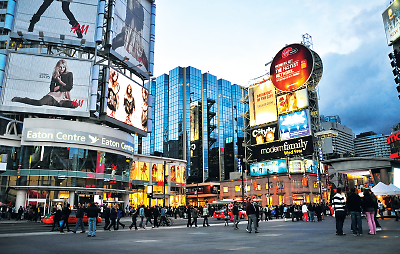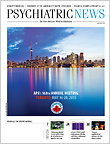APA members coming to this year’s annual meeting and hoping to really “experience” Toronto will want to visit the city’s vibrant and varied neighborhoods. Here are six “cities within a city” recommended by
Tourism TorontoDowntown Yonge. This bustling downtown neighborhood finds its heart at Yonge (pronounced “young”) and Dundas streets and is bounded by Richmond Street to the south; Grosvenor and Alexander Streets to the north; Bay Street to the west; and portions of Church Street, Victoria Street, and Bond Street to the east. It is home to the city’s most visited attraction, Eaton Centre. Modeled on European indoor gallerias flooded with natural light and creative use of interior space, Eaton Centre houses more than 230 retailers, restaurants, and services. Located at the southwest corner of Yonge and Dundas, Eaton Centre can be accessed by subway, where two stops, Dundas Station and Queen Station, converge.
The neighborhood is also host to restaurants, bars, pubs, and coffee shops that range from the quick and convenient to elegant, upscale establishments. The Ed Mervish Theater (244 Victoria Street) and the Elgin and Winter Garden Theatre (182 Yonge Street) are worth visiting for the architecture alone; the Elgin and Winter Garden are said to be the last Edwardian “stacked” theaters. Massey Hall, at 178 Victoria Street, is a landmark concert theater hosting classical, ballet, rock, jazz, and comedy performances.
Queen West is Toronto’s fashion district, located on Queen Street West between Simcoe Street and Bathurst Street. “Art meets commerce on vibrant Queen Street West, the historic area that spearheaded the growth in Toronto’s cultural life in the 1980s and ’90s,” according to the website of the Queen West Business Improvement Area. “Known then for its mixture of fashion shops, galleries, and indie music bars, the eastern part of Queen Street West has become a major shopping district, while the western half retains its unconventional roots. At night, visit an array of unique restaurants, lively patios, bars, and live music venues.”
Toronto’s Chinatown is centered around the corner of Spadina Avenue and Dundas Street West. “Elegantly stroked Chinese characters grace store and street signs,” according to Tourism Toronto. “Oriental shops and markets with exotic fruits and vegetables spill onto the sidewalk. …”
And the neighborhood prides itself on the variety of authentic Asian cuisine that diners can sample at its wide range of modest and upscale restaurants—Chinese, Thai, Japanese, and Vietnamese are all on the menu. Visitors can experience Peking duck served in two courses at the Bright Pearl, for example, or visit the Golden Leaf for dim sum available all day long. The red cow on the sign of Pho Hung marks one of the favorite destinations of locals for real Vietnamese pho.
Kensington Market, between Dundas and College streets and west of Spadina Avenue, is a maze of narrow streets and alleys lined with brightly colored Victorian houses. During the 1920s, when it was a predominantly Jewish neighborhood, families would set up stands in front of their homes and sell their goods to one another. This was the start of Toronto’s famous Kensington Market.
“Today the neighborhood and the market make up one of Toronto’s most diverse areas,” notes Tourism Toronto. “The rich multicultural mix is obvious in the shops packed with goods from Europe, the Caribbean, the Middle East, South America, and Asia. On busy days, the market is every bit as lively as street markets around the world: a cacophony of sounds, piles of fruit and vegetables, exotic spices, and sweet treats.”
Parking is extremely limited in Kensington, especially on the weekend. Two parking lots serve the area, though with limited availability. Walking is the best way to get to Kensington if you are already downtown.
Old Town-St. Lawrence Market/Distillery Historic District is an area roughly bordered by Yonge Street to the west, the Don River to the east, Queen Street East to the north, and the city’s railway lines to the south. It’s an important historical area that dates to Toronto’s beginnings in the early 19th century. Revitalized areas and buildings such as the Distillery District, the picturesque Flatiron Building, St. Lawrence Market, Front Street, and King Street have made this community popular with shoppers, art lovers, and photographers looking for a glimpse into Toronto’s history. Visitors will enjoy walking along the neighborhood’s cobblestone streets and taking in the flourishing arts and culture scene.
Greektown, on Danforth Avenue between Chester Avenue and Dewhurst Boulevard, is an integral part of Toronto’s identity. The Greek community started with only 20 Greek names listed in 1907 and has grown to become the second-largest outside of Greece itself—a testament to the area’s strong character and welcoming atmosphere. The streets are lined with the unmistakable blue and white of the Greek flag, and signs are displayed in both English and Greek. It is a premier destination for shopping, dining, strolling, patio sitting, and people watching. ■
For more images of Toronto’s unique neighborhoods, click
here.

